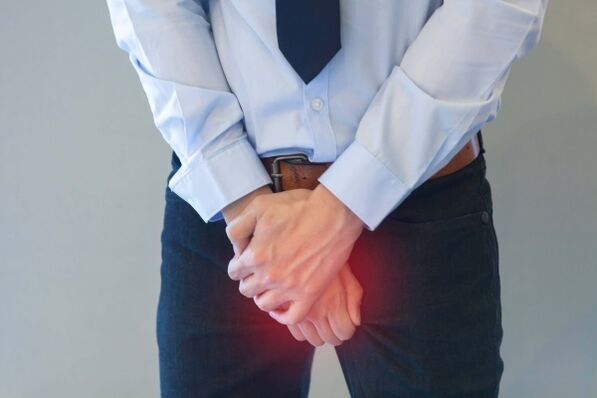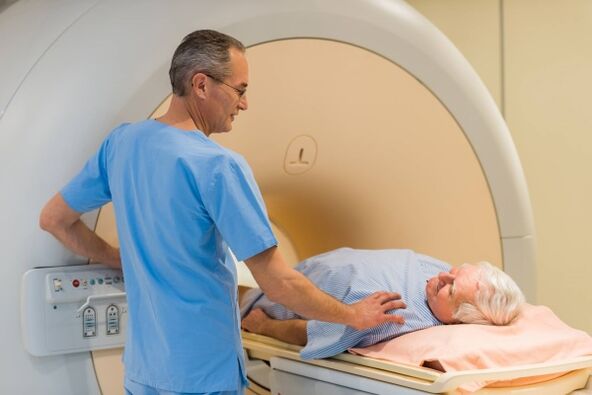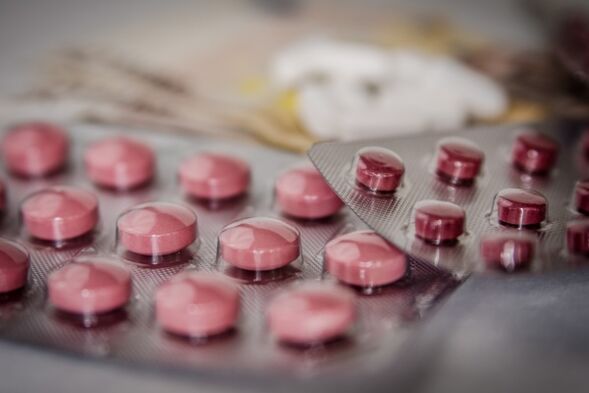Acute prostatitis is characterized by a clear clinical picture. The pathology is dangerous with a number of serious complications, therefore requires timely and complex treatment. How to recognize and treat the disease is described in this article.
Acute prostatitis is an inflammatory disease, which is accompanied by obvious painful sensations and can pose a great danger to health. For a successful prognosis of the disease, you should see a doctor in a timely manner for diagnosis and prescribe competent treatment.
General features of this disease
Acute prostatitis is a rapidly developing inflammatory process of the prostate gland. It has four stages of development:
- Catarrhal.At this stage, the gland swells slightly, inflammation only affects the mucous membrane of the glandular excretory tract. This period is the best moment for treatment - if you start it at this time, you can get rid of the disease in less than two weeks. The inflammatory nature is not purulent, but the edema that appears clogs the ducts, preventing secretions from coming out of the glands. Stagnation begins.
- Follicular.As a result of stagnation, bacteria that have entered the organ begin their activities that are already in it. Because organs are made up of cells, grouped into lobules and separated by connective tissue, inflammation first affects one part.
- Parenchymal.Inflammation moves from one lobe to another, there are many pustules in different parts of the gland.
- Purulent abscess.Pustules merge into one, and a bladder containing purulent contents forms in the gland. Over time, it can rupture, the pus spreads, entering the space around the prostate and bladder, urethra or rectum. When the abscess is opened, the pus does not come out completely, and this becomes a new round in the inflammatory process.
How quickly the pathological process will develop and how it will end depends on several factors: the causes of inflammation, the timeliness and appropriateness of treatment.
Cause
In 90% of cases, the cause of acute inflammation of the prostate is an infectious lesion. The causative agent can be one or several types of bacteria and viruses:
- Gonococci are one of the most dangerous bacteria, they quickly start the purulent process.
- Trichomonas is a leading genital microorganism. Therefore, entering the space between the glandular cells, requires a long stubborn treatment.
- Chlamydia - in addition to toxicity, they can clog erythrocytes, increase sedimentation rates and impede blood circulation in the affected area. They penetrate deeper than Trichomonas.
- Staphylococci, golden appearance is very common. It can persist in any tissue and organ, causing bloating and making the blood thicker.
- Ureaplasma is a cross between unicellular and viral. Can enter the prostate from the urinary tract or through unprotected intercourse.
- Escherichia coli is a gram-negative bacterium, a frequent causative agent of acute inflammation. It enters the body due to inadequate hygiene during food preparation.
This is not a complete list of bacteria and viruses that can cause acute inflammation of the prostate gland.
Often the reason is not just due to an infection that can live in the body for a long time without symptoms. They start to grow rapidly when there are contributing factors to this:
- Regular or one -time hypothermia. Cold weakens the body’s defenses and makes it harder for them to contain pathogenic bacteria, especially if hypothermia is associated with daily work.
- Irregular sex life. Stagnation of glandular secretions (which are an integral part of sperm) encourages bacterial reproduction.
- Infects the infection. This can be an infection caused by unprotected sex, or bacteria that cause mild inflammation of the urinary tract. Consequences of purulent sore throat that does not heal completely in the form of streptococcus can also cause inflammation. Even tooth decay can cause prostatitis.
- Weakened immunity. If, as a result of illness or uncontrolled antibiotic intake, the body’s defenses become inadequate, the bacteria will inevitably manifest themselves.
- Not following the rules of personal hygiene.
Symptoms of Acute Prostatitis
Symptoms depend on the stage of the disease.
During the period of catarrhal prostatitis, there is slight discomfort and a feeling of heaviness in the perineum, the urge to use the toilet at night becomes more frequent. Urination is accompanied by burning and pain. The gland itself is normal or enlarged uncritically, palpation examination causes pain. The temperature remained normal or slightly increased. No poisoning, overall well -being.
The follicular period has more manifestations. The pain increases, becomes persistent, sometimes radiating sharply to the penis, sacrum or rectum. Urinary retention appears, as urination is difficult to perform due to acute pain. Defecation is also accompanied by severe pain.
The temperature rose to 38 degrees and remained at this level. The prostate gland feels enlarged, has a dense, tense consistency, touching it in several places causes a sharp pain.

Parenchymal prostatitis is very difficult. Appetite is lost, chills appear, general weakness. Frequent urges to the toilet with short urination are replaced by acute urinary retention. Trying to empty the bladder or intestines becomes almost impossible because of the unbearable pain. It is exacerbated by constipation and a full bladder, spreading throughout the perineum, little relief can only occur in a prone position with the legs tucked.
The temperature rose above 39 degrees. Inflammation begins to spread to other organs, mucus is removed from the rectum. The prostate gland has an indistinct, enlarged and painful outline. Palpation is unlikely to occur because of edema.
The formation of abscesses is accompanied by localization of the point of acute pain - where the abscess appears. The urinary tract, stools and gas are very difficult, accompanied by severe throbbing pain that spreads to the intestines. Temperatures above 39. 5 degrees, chills, fever, and sometimes delusional states appear.
Then, unexpectedly, relief came: the pain disappeared, the temperature dropped. However, this does not mean that the patient has healed: the fact is that the abscess has ruptured and now an immediate procedure is needed to clean the body of pus, because the negative consequences can be very diverse.
Diagnostics
Diagnosis is made based on assessment of patient complaints, analysis of urine, blood and prostate secretions. In addition, they use digital rectal diagnostic methods, ultrasound and CT.
The severity of urinary disorders was assessed using uroflowmetry.
General analysis of urine allows you to identify the disease at an early stage, when the characteristic symptoms are still absent. The alkaline acidity index itself indicates the development of inflammation.
Bacteriological examination of urine allows you to determine the nature of the inflammation and its causes. Changes in the color, odor, or consistency of urine are not considered absolute evidence of acute prostatitis.
Complete blood counts are fundamental in the study of this disease. Characteristic indicators of acute prostatitis are low hemoglobin levels (normal 130 g / l), high levels of urea and creatinine, as well as leukocyte levels and erythrocyte sedimentation rates. Protein should not be normal, as well as high levels of leukocytes - should not be more than 5 units.
PSA -specific analysis allows you to identify not only inflammation, but also malignant formations.
PCR research allows you to identify genital infections that are often the cause of acute prostatitis.
Ultrasound allows you to determine the size of the prostate gland, its edges, the presence of spots and diffuse changes. If an abscess has formed, the study can determine its size and location. If possible, the study was conducted transrectally; if pain and swelling do not allow this, a study of the gland is done from the side of the abdomen.
Sometimes ultrasound is performed by observing changes in the frequency of sound reflected from the organ. This allows you to assess the blood supply to the prostate - vascularization, which can increase or decrease depending on the type of inflammation and its degree. Allows you to differentiate cancerous tumors from acute prostatitis.
If the doctor determines that surgery needs to be performed, he or she prescribes a CT or MRI to check the details of the inflammatory process.

Treatment of acute prostatitis
Disease therapy is always complex, including taking different medications, procedures and diets. Treatment can last about 2 months.
The main task of the doctor is to eliminate the cause of inflammation, which most often consists of infection. For this, antibiotics are prescribed (alone or in combination). The choice of medication depends on several factors:
- pathogen sensitivity;
- patient -related illness;
- mode of action of drugs.
Diagnosis and self -therapy are not possible: effective drugs are selected based on laboratory tests
To combat the causative agents of acute inflammatory processes, fluoroquinolones and third -generation cephalosporins are most often used. For the treatment of acute prostatitis, the bacterial effect of antibiotics is very important.
Depending on the stage and condition of the patient, the dose and form of drug release are chosen: the more conditions are ignored, the higher the dose and the more important it is for the drug to reach its destination more quickly, therefore, drugs in injectable form are preferred over tablets.
It is necessary to normalize the outflow of urine and secretions. If urinary retention has turned into an acute form, trocar epicstomy is prescribed - a puncture of the bladder, followed by the introduction of a thin tube.
If such drastic action is not required, non-steroidal anti-inflammatory drugs are prescribed to restore normal urination, which eliminates swelling and pain. The drugs are prescribed in the form of tablets, injections or rectal suppositories.
If acute prostatitis has turned into an abscess, treatment depends on its stage. The infiltration stage is treated with active therapy with antibiotics and immunostimulants. Blockages are given with painkillers to help the patient cope with the pain.
If an abscess has formed, treatment can only be done with the help of surgical intervention: the purulent bladder is opened, washed, and drainage installed. After surgery, therapy is prescribed to combat microbes and intoxication.
Treatment of acute prostatitis is not limited to symptom relief. Antibiotics must be taken to the end, and not until the pain goes away.
After the spasm itself is removed, it’s time for physiotherapy. It includes UHF and microwave procedures, electrophoresis and prostate massage. The purpose is to relieve swelling (if left untreated), to improve the outflow of glandular secretions to avoid congestion.
It is important to adhere to your diet throughout treatment. You must decline the following products:
- alcoholic beverages, coffee, fried and salty - contribute to the emergence of congestion;
- white cabbage, apples, legumes and raw vegetables - cause bloating, as a result of which the pelvic organs, including the prostate, are compressed;
- acidic drinks, intestines - they irritate the urinary tract.
The diet should include whole grains, boiled vegetables, dairy products and roasted fruits. All this contributes to the normal function of the intestine. You need to adhere to drinking rules, drink at least 2 liters of fluids (water, fruit drinks, juices) per day. The more often the urinary tract is removed, the smaller the risk of inflammation.
Vitamin and peptide complexes should be taken to promote tissue regeneration and the restoration of normal glandular function quickly.

Good treatment methods are assessed by the restoration of glandular tissue, normalization of chemical indicators of prostate secretion, the absence of pathogens in the analysis and the general well -being of the patient.
Prognosis and complications
The earlier treatment is started, the faster and easier it is to get rid of acute prostatitis. Complications of each subsequent stage of the disease, chronic diseases, the spread of inflammation to other organs, infertility, sepsis. If the disease has already started, it may be necessary to remove the gland itself.
With timely treatment, at the end of therapy, all bodily functions are restored, work ability is fully restored.
prevention
Preventive measures include the absence of unprotected sexual intercourse (to exclude IMS), careful hygiene, and timely treatment of inflammatory processes in the urinary tract. It is necessary to maintain the immune system, not to start a careful tooth and treat infectious diseases with caution.
You should also exclude the factors that contribute to the development of this disease. For this, you need:
- having a regular sex life with one partner;
- avoid hypothermia (permanent and only once);
- stop drinking alcohol, smoking and a sedentary lifestyle;
- undergo routine examinations by a urologist;
- do not self-medicate at the first signs of the inflammatory process;
- stick to a balanced diet;
- taking vitamins, especially during the period of the spread of infectious diseases.
Acute prostate inflammation appears due to an infection that develops in good condition. Treatment is carried out with antibiotics, anti-inflammatory drugs, painkillers and vitamins. During the period of therapy, it is important to adhere to diet and drink.































